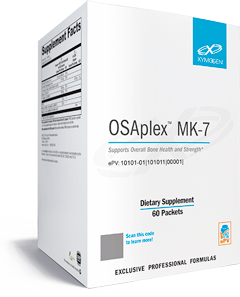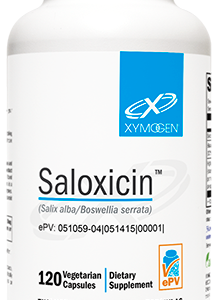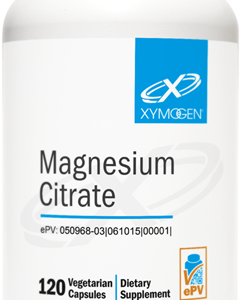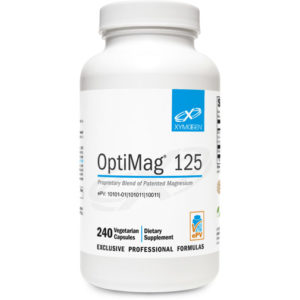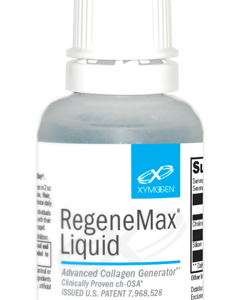Scientific Information/Data
Bone health is dependent on a constant supply of micronutrients for maintenance and repair. Instead of adopting a single-nutrient, unbalanced approach to supplementation, Xymogen utilizes an array of complementary, well-researched nutrients in its OSAplex™ MK-7 line of formulas to build and maintain bone over time.*
OSAplex™ MK-7 is our original formula, and it provides ch-OSA®, MCHC (microcrystalline hydroxyapatite concentrate), and vitamin D3.
ch-OSA® (Choline-Stabilized Orthosilicic Acid)
ch-OSA is a patented, stabilized, readily absorbed, and bioactive form of silicon called orthosilicic acid. Because regular orthosilicic acid is highly unstable, leading it to form polymers, and because the polymers are too large for the human body to absorb, ch-OSA features patented “choline stabilization” technology. This stabilization prevents polymers from forming, ensuring optimal absorption of orthosilicic acid.*
Decades of research suggest that there is a positive association between dietary silicon and bone mineral density (BMD).[1] The mechanisms of action appear to be silicon’s support of collagen synthesis and stabilization, extracellular matrix mineralization, and connective tissue integrity.[2,3] Cell-line studies have shown that type I collagen synthesis is stimulated by orthosilicic acid (silicon).[4] Type I collagen is a dense, heavily cross- linked protein that creates an extremely high tensile strength[5] and contributes to bone strength and flexibility. These strong collagen strands are believed to create core-post “binding sites” for calcium and other bone minerals.*[6-8]
In a 12-month clinical trial conducted at St. Thomas’ Hospital in London, women already taking 1000 mg of calcium and 800 IU of vitamin D, to which they added ch-OSA, saw thighbone mineral density at the hip (i.e., femoral neck) increase by 2.00% compared to placebo. This was as a result of an increase in actual bone formation, not just a decrease in loss.[9] Furthermore, the procollagen marker P1NP (procollagen type-1 N-terminal propeptide) increased significantly after 12 months in women who took ch-OSA compared to women in the placebo group. P1NP is known as the most sensitive marker for bone collagen formation and an early marker of bone formation.[9] Animal studies support the human clinical findings for ch-OSA with respect to collagen formation and BMD.*[6,7,10]
Microcrystalline Hydroxyapatite Concentrate (MCHC)
XYMOGEN uses standardized, safe, bovine-sourced MCHC (Ossopan) from New Zealand. The OIE-World Organisation for Animal Health
has classified New Zealand as a “negligible BSE risk country,” the most favorable official classification a country can be given.[11] MCHC is manufactured under proprietary processes that meet FDA, USDA, and EU regulatory requirements, and frequent heavy metal assays assure purity. Proprietary techniques preserve the bioactive contents of bone and create a naturally balanced formula because whole-bone extract provides an array of nutrients found in healthy bone: calcium, phosphorus, magnesium, bioactive growth factors, type I collagen, amino acids, glycosaminoglycans, and a broad range of essential trace elements. Gentle processing retains the delicate protein matrix and organic factors, and X-ray-diffraction analysis confirms the microcrystalline structure. The MCHC is assayed for hydroxyproline content and the collagen content is greater than 22% with the majority being type l, the predominant collagen occurring in bone.*
Decades of scientific studies suggest that Ossopan/MCHC supplementation fundamentally supports BMD and bone health.[12-15] A meta- analysis of six controlled studies suggested that hydroxyapatite was significantly more effective than calcium carbonate in supporting bone structure and BMD, and another study favorably compared its absorption to calcium gluconate.*[16,17]
Vitamin D3
Although vitamin D3 (cholecalciferol) is made in the skin when 7-dehydrocholesterol reacts with sunlight, many things affect the degree to which this biosynthesis occurs, including time of day, seasons, location, smog/pollution, clothing, shade of skin (darker skin requires more sun), and sunscreen use. Low-cholesterol diets and certain cholesterol therapies can also affect vitamin D formation. By some estimates, one billion people worldwide have vitamin D deficiency or insufficiency.[18] The body needs vitamin D to absorb calcium, and the importance of vitamin D in skeletal health and bone density is well-established. Without adequate absorption, the body must take calcium from its stores in the skeleton, which weakens existing bone and prevents the formation of strong, new bone. Researchers suggest that vitamin D supplementation may decrease bone turnover and increase BMD.[19] A pooled analysis evaluating 11 randomized, double-blind, placebo-controlled trials supported this analysis. It concluded that vitamin D supplementation (> 800 IU daily) was favorable in maintaining hip and nonvertebral bone integrity in individuals aged 65 and older.*[20]
Although D2 and D3 are similar biochemically, one study demonstrated D3 to be approximately 87% more potent in raising and maintaining serum calcidiol (the body’s storage form) concentrations and in producing two- to threefold greater storage of vitamin D than did equimolar D2.*[21]
OSAplex™ MK-7 provides the same ingredients found in Osteo MK-7 (ch-OSA, MCHC, and D3) as well as vitamin K2 as menaquinone-7 (MK-7).
Vitamin K2
MK-7 is a bioactive, bioavailable form of vitamin K2.[22] The biological role of vitamin K in relation to calcium and bone is to help deposit calcium into appropriate areas in the body, such as bones and teeth. Conversely, vitamin K is needed to prevent the accumulation of calcium in other areas, such as in arteries and soft tissues, through vitamin K-dependent carboxylation of Gla proteins. Vitamin K also supports bone integrity by moderating the synthesis of prostaglandin E2 (PGE-2) and interleukin-6 (IL-6) by osteoclasts.[23,24] A three-year study utilizing 180 mcg/d of MK-7 concluded that MK-7 significantly improved vitamin K status, supported bone mineral content and BMD, and favorably supported bone strength and integrity in healthy postmenopausal women.*[25]
Bonolive Olive Leaf Extract
Bonolive is a pharmaceutical-grade olive leaf extract that features a unique polyphenol complex (40% polyphenols), including oleuropein. This proprietary olive leaf extract preparation is fully water-soluble, which makes its oral bioavailability superior. Historical and traditional use as well as clinical testing and toxicological assessment confirm the safety of its oral consumption.*[26,27]
Stem cell research has shown that olive polyphenol bioactivity is associated with increased osteoblast formation, increased extracellular matrix mineralization, and overall bone maintenance.[28] Five preclinical studies in a well-established rat model for bone health demonstrated that olive polyphenols exert protective effects on the formation and maintenance of bone.[29-33] In addition, a randomized, double-blind, placebo-controlled clinical study provided strong support for Bonolive supplementation. The results of this study revealed that 250 mg/d of Bonolive promoted a statistically significant improvement (32% increase) in levels of the bone formation marker osteocalcin over a 12-month period. Furthermore, DEXA scan results suggested that Bonolive supplementation positively supported BMD at the lumbar spine and the femur neck compared to placebo.
[26] The treatment group also experienced reduced adipocyte formation and a positive effect on lipid metabolism (i.e., cholesterol and triglycerides), confirming Bonolive’s double mode of action: to positively influence bone health and cardiovascular health. Other research continues to confirm the positive cardiovascular effects of olive leaf extract and oleuropein at varying doses.*[34-37]
Certain cytokines (IL-1, TNF-alpha, IL-6) are thought to be involved in bone turnover regulation by increasing bone resorption.[30] Moreover, an excess of reactive oxygen species can impair bone metabolism and lead to bone loss.[38] In experimental animal studies on ovariectomized rats, oleuropein and olives were shown to improve cytokine and oxidative status and thereby support bone maintenance.[29-32] Garcia-Villalba et al demonstrated the superior oral bioavailability of Bonolive polyphenols and their positive effect on antioxidant status in pre- and postmenopausal women.[39] Furthermore, the oxidative stress marker malondialdehyde (MDA), formed in the process of lipid oxidation, decreased by 32% after supplementation.*
As an interesting note, a synergistic effect of olive oil and vitamin D has been proposed. Tagliaferri et al demonstrated that virgin (high polyphenol content) olive oil fortified with vitamin D3 helped maintain bone density in mice challenged by estrogen deprivation.*[38]
*These statements have not been evaluated by the Food and Drug Administration. This product is not intended to diagnose, treat, cure, or prevent any disease.
References
- Jugdaohsingh R. Silicon and bone health. J Nutr Health Aging. 2007 Mar-Apr;11(2):99-110. [PMID: 17435952]
- Silicon. Natural Medicines. https://naturalmedicines.therapeuticresearch.com/databases/food,-herbs-supplements/professional.aspx?productid=1096. Accessed March 3, 2016.
- Martin KR. Silicon: the health benefits of a metalloid. Met Ions Life Sci. 2013;13:451-73. [PMID: 24470100]
- Reffitt DM, Ogston N, Jugdaohsingh R, et al. Orthosilicic acid stimulates collagen type 1 synthesis and osteoblastic differentiation in human osteoblast-like cells in vitro. Bone. 2003 Feb;32(2):127- 35. [PMID: 12633784]
- Blair HC, Robinson LJ, Huang CL, et al. Calcium and bone disease. Biofactors. 2011 May-Jun;37(3):159-67. [PMID: 21674636]
- Calomme MR, Vanden Berghe DA. Supplementation of calves with stabilized orthosilicic acid. Effect on the Si, Ca, Mg, and P concentrations in serum and the collagen concentration in skin and cartilage. Biol Trace Elem Res. 1997 Feb;56(2):153-65. [PMID: 9164661]
- Calomme MR, Geusens P, Demeester N, et al. Partial prevention of long-term femoral bone loss in aged ovariectomized rats supplemented with choline-stabilized orthosilicic acid. Calcif Tissue Int. 2006, Apr;78(4): 227-32. [PMID: 16604283]
- Viguet-Carrin S, Garnero P, Delmas PD. The role of collagen in bone strength. Osteoporos Int. 2006;17(3):319-36. [PMID: 16341622]
- Spector TD, Calomme MR, Anderson SH, et al. Choline-stabilized orthosilicic acid supplementation as an adjunct to calcium/vitamin D3 stimulates markers of bone formation in osteopenic females: a randomized, placebo-controlled trial. BMC Musculoskelet Disord. 2008 Jun 11;9:85. [PMID: 18547426]
- Calomme MR, Wijnen P, Sindambiwe JB, et al. Effect of choline-stabilized orthosilicic acid on bone density in chicks. Calcif Tissue Int. 2002, 70:292. Poster presented at: 29th European Symposium on Calcified Tissues; May 25-29, 2002; Zagreb, Croatia. Abstract P-139. http://www.ectsoc.org/zagreb2002/poster3.htm. Accessed April 26, 2016.
- Bovine Spongiform Encephalopathy (BSE). OIE-World Organization for Animal Health Web site. http://www.oie.int/animal-health-in-the-world/official-disease-status/bse/list-of-bse-risk-status/. Accessed April 26, 2016.
- Pelayo I, Haya J, De la Cruz JJ, et al. Raloxifene plus ossein-hydroxyapatite compound versus raloxifene plus calcium carbonate to control bone loss in postmenopausal women: a randomized trial. Menopause. 2008 Nov-Dec;15(6):1132-38. [PMID: 18791486]
- Castelo-Branco C, Pons F, Vicente JJ, et al. Preventing postmenopausal bone loss with ossein-hydroxyapatite compounds. Results of a two-year, prospective trial. J Reprod Med. 1999 Jul;44(7):601-05. [PMID: 10442322]
- Albertazzi P, Steel SA, Howarth EM, et al. Comparison of the effects of two different types of calcium supplementation on markers of bone metabolism in a postmenopausal osteopenic population with low calcium intake: a double-blind placebo-controlled trial. Climacteric. 2004 Mar;7(1):33-40. [PMID: 15259281]
- Rüegsegger P, Keller A, Dambacher MA. Comparison of the treatment effects of ossein-hydroxyapatite compound and calcium carbonate in osteoporotic females. Osteoporos Int. 1995 Jan;5(1):30-34. [PMID: 7703621]
- Castelo-Branco C, Ciria-Recasens M, Cancelo-Hidalgo MJ, et al. Efficacy of ossein-hydroxyapatite complex compared with calcium carbonate to prevent bone loss: a meta-analysis. Menopause. 2009 Sep-Oct;16(5):984-91. [PMID: 19407667]
- Buclin T, Jacquet AF, Burckhardt P. Intestinal absorption of calcium gluconate and oseine-mineral complex: an evaluation by conventional analyses [in French]. Schweiz Med Wochenschr. 1986 Dec 13;116(50):1780-83. [PMID: 3026039]
- Tsiaras WG, Weinstock MA. Factors influencing vitamin d status. Acta Derm Venereol. 2011 Mar;91(2):115-24. [PMID: 21384086]
- Lips P, van Schoor NM. The effect of vitamin D on bone and osteoporosis. Best Pract Res Clin Endocrinol Metab. 2011 Aug;25(4):585-91. [PMID: 21872800]
- Bischoff-Ferrari HA, Willett WC, Orav EJ, et al. A pooled analysis of vitamin D dose requirements for fracture prevention. N Engl J Med. 2012 Jul 5;367(1):40-49. [PMID: 22762317]
- Heaney RP, Recker RR, Grote J, et al. Vitamin D3 is more potent than vitamin D2 in humans. J Clin Endocrinol Metab. 2011 Mar;96(3):E447-52. [PMID: 21177785]
- Schurgers LJ, Teunissen KJ, Hamulyák K, et al. Vitamin K-containing dietary supplements: comparison of synthetic vitamin K1 and natto-derived menaquinone-7. Blood. 2007 Apr 15;109(8):3279-83. [PMID: 17158229]
- Weber P. Management of osteoporosis: is there a role for vitamin K? Int J Vitam Nutr Res. 1997;67(5):350-56. [PMID: 9350477]
- Shearer MJ. The roles of vitamins D and K in bone health and osteoporosis prevention. Proc Nutr Soc. 1997 Nov;56(3):915-37. [PMID: 9483660]
- Knapen MH, Drummen NE, Smit E, et al. Three-year low-dose menaquinone-7 supplementation helps decrease bone loss in healthy postmenopausal women. Osteoporos Int. 2013 Sep;24(9):2499-507. [PMID: 23525894]
- Filip R, Possemiers S, Heyerick A, et al. Twelve-month consumption of a polyphenol extract from olive (Olea europaea) in a double blind, randomized trial increases serum total osteocalcin levels and improves serum lipid profiles in postmenopausal women with osteopenia. J Nutr Health Aging. 2015 Jan;19(1):77-86. [PMID: 25560820]
- Clewell AE, Béres E, Vértesi A, et al. A comprehensive toxicological safety assessment of an extract of Olea Europaea L. leaves (BonoliveTM). Int J Toxicol. 2015 Dec 10. pii: 1091581815619764. Epub ahead of print. [PMID: 26658007]
- Santiago-Mora R, Casado-Díaz A, De Castro MD, et al. Oleuropein enhances osteoblastogenesis and inhibits adipogenesis: the effect on differentiation in stem cells derived from bone marrow. Osteoporos Int. 2011 Feb;22(2):675-84. [PMID: 20495905]
- Puel C, Mardon J, Agalias A, et al. Major phenolic compounds in olive oil modulate bone loss in an ovariectomy/inflammation experimental model. J Agric Food Chem. 2008 Oct 22;56(20):9417- 22. [PMID: 18800805]
- Puel C, Mathey J, Agalias A, et al. Dose-response study of effect of oleuropein, an olive oil polyphenol, in an ovariectomy/inflammation experimental model of bone loss in the rat. Clin Nutr. 2006 Oct;25(5):859-68. [PMID: 16740345]
- Puel C, Quintin A, Agalias A, et al. Olive oil and its main phenolic micronutrient (oleuropein) prevent inflammation-induced bone loss in the ovariectomised rat. Br J Nutr. 2004 Jul;92(1):119-27. [PMID: 15230995]
- Puel C, Mardon J, Kati-Coulibaly S, et al. Black Lucques olives prevented bone loss caused by ovariectomy and talc granulomatosis in rats. Br J Nutr. 2007 May;97(5):1012-20. [PMID: 17408530]
- Hagiwara K, Goto T, Araki M, et al. Olive polyphenol hydroxytyrosol prevents bone loss. Eur J Pharmacol. 2011 Jul 15;662(1-3):78-84. [PMID: 21539839]
- Lockyer S, Rowland I, Spencer JP, et al. Impact of phenolic-rich olive leaf extract on blood pressure, plasma lipids and inflammatory markers: a randomised controlled trial. Eur J Nutr. 2016 Mar 7. ePub ahead of print. [PMID: 26951205]
- Romero M, Toral M, Gómez-Guzmán M, et al. Antihypertensive effects of oleuropein-enriched olive leaf extract in spontaneously hypertensive rats. Food Funct. 2016 Jan 20;7(1):584-93. [PMID: 26593388]
- Susalit E, Agus N, Effendi I, et al. Olive (Olea europaea) leaf extract effective in patients with stage-1 hypertension: comparison with Captopril. Phytomedicine. 2011 Feb 15;18(4):251-58. [PMID: 21036583]
- Perrinjaquet-Moccetti T, Busjahn A, Schmidlin C, et al. Food supplementation with an olive (Olea europaea L.) leaf extract reduces blood pressure in borderline hypertensive monozygotic twins. Phytother Res. 2008 Sep;22(9):1239-42. [PMID: 18729245]
- Tagliaferri C, Davicco MJ, Lebecque P, et al. Olive oil and vitamin D synergistically prevent bone loss in mice. PLoS One. 2014 Dec 31;9(12):e115817. [PMID: 25551374]
- García-Villalba R, Larrosa M, Possemiers S, et al. Bioavailability of phenolics from an oleuropein-rich olive (Olea europaea) leaf extract and its acute effect on plasma antioxidant status: comparison between pre- and postmenopausal women. Eur J Nutr. 2014 Jun;53(4):1015-27. [PMID: 24158653]


